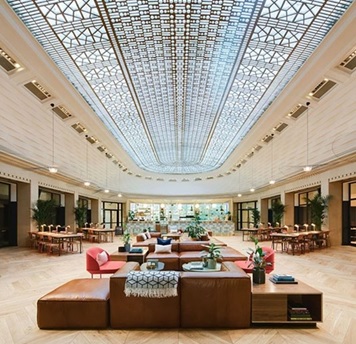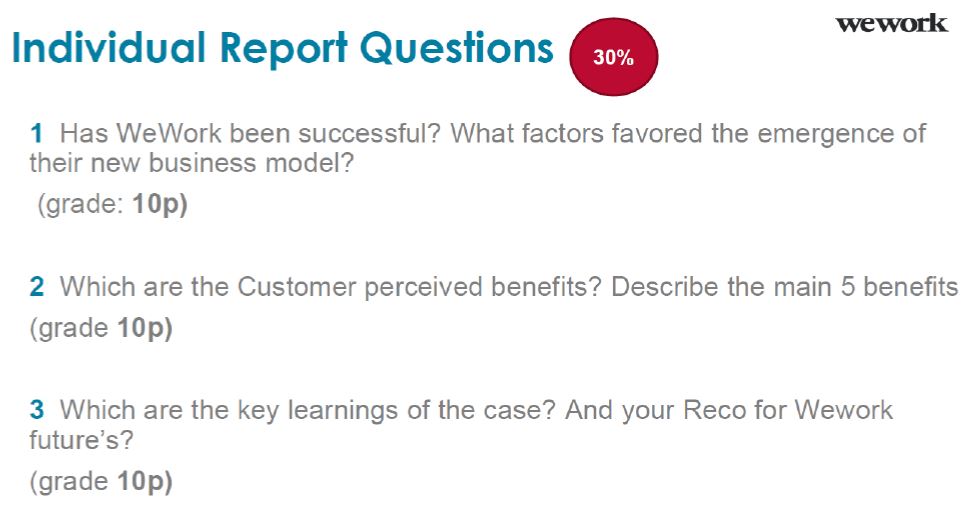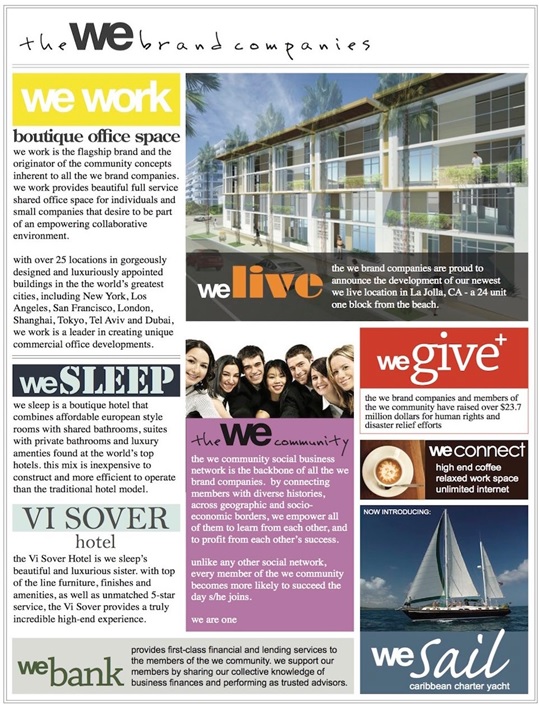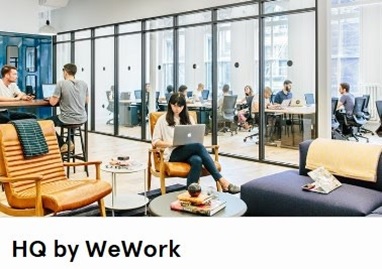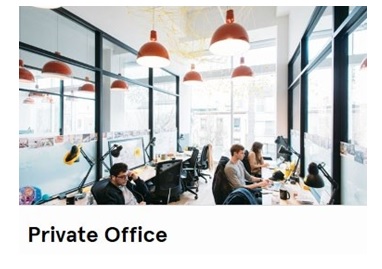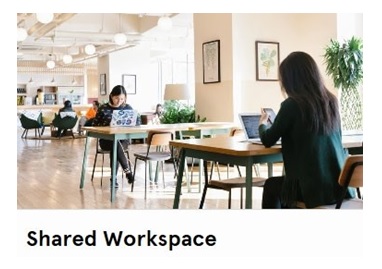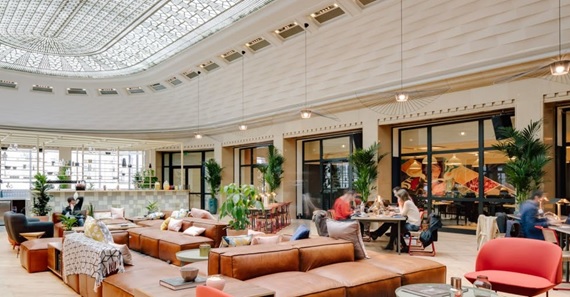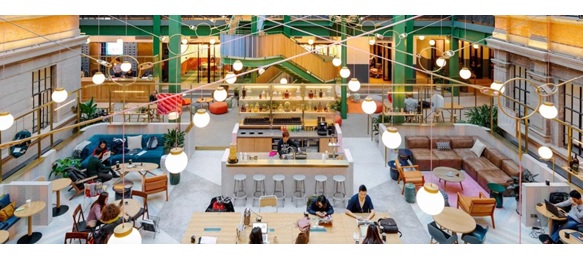- Case StudyHelp.com
- Sample Questions
WeWork – Service Excellence through Business Model Innovation: Creating Outstanding Customer Experiences by Leveraging Data, Analytics and Digital Technologies
- Topic :: Building a MKT plan in a digital world
- Document Type :: Essay writing (any type)
Our view is that there is tremendous wind at our back—we are the only serious global player out there. Our growth is accelerating as our product offering continues to reach deeper and reach not just small-sized companies but Fortune 500 companies and everything in between.”
Michael Gross, Vice Chairman, WeWork
The Concourse Hall of Los Angeles’s Convention Centre was packed with 6,000 employees of WeWork, the global shared office provider. The company’s three-day global summit in January 2019 was in full swing, with the Red Hot Chili Peppers, Sean “Diddy” Combs, Ashton Kutscher and Jaden Smith slated to attend. When WeWork CEO Adam Neumann bounded onto the stage to thundering applause, he might have been one of the rock star guests. Employees in the balcony held up a trio of signs that said “We-Not-Me”. “We” had come to have huge resonance for Neumann and co-founder Miguel McKelvey, who referred to those who worked for WeWork and rented its office space part of “the We generation”.
Headquartered in the Chelsea neighbourhood of New York City, WeWork was a global service provider of shared workspaces for freelancers, start-ups, small businesses and a growing number of large enterprises, from Facebook to IBM. As of January 2019, the company had more than 425 locations in 27 countries (90 cities) worldwide, where over 400,000 “members” paid from $45 a month for as-you-go access, $190 for a rotating “hot desk”, $450 for a private office, to thousands of dollars for multi-floor offices. All of these were kitted out with high-speed Internet, business quality printers, micro-roasted coffee, craft beer and draft kombucha on tap, discounts on software, gym membership, and the difficult-to-quantify “cool vibe”.
WeWork was a growth machine: the company spent $ 2.5 billion in 2018 on expanding its global operations. In financial records released in April 2019, WeWork told bondholders that its “growth and new market development” expense had more than tripled in 2018, while sales and marketing costs were $ 379 million, up 164% from the year before. Overall operating costs had grown 93% to reach $ 3.5 billion, while revenues had more than doubled to $ 1.8 billion. At the same time, WeWork’s latest market valuation stood at 16 times that of its largest rival IWG (Regus and Spaces brands). Yet, unlike its competitor, WeWork experienced fast growth: almost two thirds of its 425 buildings were open for less than 18 months.
On January 8, the first day of the Global Summit, Neumann announced a startling strategic and corporate shift: WeWork was rebranding to become The We Company, an umbrella corporation under which the co-working company would be one of three units – along with WeLive, the fledgling co-living organization, and WeGrow, a nascent business that included a for-profit elementary school and a coding academy. In addition to building out these two divisions, which had grown at a slower pace than WeWork – and possibly creating more – Neuman said The We Company would be hiring over 1,000 new engineers.
At the summit and online, Neumann and McKelvey emphasized that shifting beyond the shared office business would help fulfil their early vision of “creating something greater than ourselves”. They displayed graphics of the original pitch deck created six months before founding WeWork (see Exhibit 1) – they’d had plans for everything from WeBank to WeSleep (boutique hotels) to WeSail (chartered cruises).7 The company blog explained:
The idea that began in New York nine years ago was always about more than work— it was about supporting all aspects of life. As we’ve built WeWork, our community taught us that we are more alike than different. It taught us that we all thrive when we have a purpose. And it taught us that experiences bring more fulfilment and joy than material goods.
But experiences like the ones WeWork delivers need material goods — make that “billions of dollars” — to build and grow. The rebranding was a surprise, coming on the heels of a company setback in late December 2018. WeWork’s largest investor, Softbank, had been preparing to purchase $16 billion in shares, buying out the company’s existing major investors and fuelling its ambitious growth plans – but then pulled back. The market was roiling, Softbank’s investors were balking, and its CEO Masayoshi Son told Neumann that the transaction would not happen.
Over the Christmas holidays, however, Neumann and Son came to a new agreement by which WeWork would receive $2 billion (added to the $8 billion Softbank had previously ploughed into the company) at an enterprise valuation of $47 billion. The scaled-back deal was announced in the business press a day before the rebranding. Sceptics in the business community and rivals in the co-working space questioned the lofty valuation for a company that, although marketed as a tech company, was essentially a real estate company — one inevitably affected by economic downturns and falling rent levels.
So despite the fanfare as WeWork headed into 2019 with a new company name, a successful global summit, tremendous goodwill and impressive growth momentum, it faced some steep challenges. Given its ballooning losses, how much more growth could the company digest before it became too much? Was rebranding WeWork as the “We Company” the right move? In an industry with low barriers to entry and cut-throat competition from rivals such as Convene, Knotel, Spaces and Regus (among others) how could WeWork continue to provide a better customer experience, at a lower cost, while wringing more dollars per square foot from its locations than its competitors? Would its early-mover status and ability to scale be enough to weather the storm?
Chill Beginnings of a “…Hot-Desking Behemoth”
Miguel McKelvey met Israeli entrepreneur Adam Neumann in New York in 2008, the year of the global financial crash. McKelvey, lead architect at Jordan Parnass in the trendy Brooklyn neighbourhood of Dumbo, convinced Neumann to move his baby-clothing company, Krawlers, to the same building, where they noticed it had many vacancies as well as its fair share of “really cool start-ups”. The level of service for these tenants was nil, so Neumann came up with the idea to lease space at $20/sq. foot, build it out with great furniture and services, and then sub-let it to fellow entrepreneurs on a month-to-month basis – at a profit.
Also Read: Assignment Help on Corporate Reputation and Responsibility
For weeks, Neumann pushed the idea to the landlord, Joshua Guttman (since the pair knew nothing about real estate). Guttman, who had built a New York real estate empire over decades, finally relented, and the two opened a floor in another of his Dumbo buildings, called Green Desk, a coworking space with a focus on sustainability. After they ran seven ads on Craigslist, the floor was 90% full and they were profitable right off the bat. Tenants put rent money down even while offices were still marked out with masking tape. But it soon became clear that their global aspirations did not mesh with simply taking space in Guttman’s existing buildings. The two entrepreneurs sold him Green Desk for $3 million, using the proceeds in 2010 to start the first WeWork in New York’s Soho neighbourhood.
McKelvey brought his architectural vision and savvy to create spaces that did not have an “office- y” feel yet were not like the tech co-working spaces where engineers shared a big open room and sat at computers with headsets on (see Exhibits 1 and 2). For Neumann, the early vision of WeWork was not about starting a coworking business but a grander goal: blurring the line between work and life: “We wanted to change the way people work.” McKelvey agreed that the biggest take away from Green Desk was having Neumann’s sweeping vision confirmed by experience:
When it was really working, it was cool that there were connections between people.
…Late at night, across the hall, you’d hear people talking about life and about business. And another thing that happens is accountability… people become accountable to each other even though they’re not working for the same companies.
The rise of WeWork was also thanks to its ability to tap into a number of trends that fertilized the seed of the original business model and spurred its phenomenal growth.
Trends Converge to Create the WeWork Moment
McKelvey and Neumann formed a coworking venture in 2008 at the height of the Great Recession, which “…exploded the notion that a ‘traditional job’ was truly secure, forcing many people to go freelance and made freelancing’s eggs-in-many-baskets risk-management strategy much more attractive.” This was the beginning of the gig economy.
For millennials in particular, fresh out of college, trying to find work during a time of hiring freezes and lower salaries, freelancing and entrepreneurial ventures were more attractive. They, and the Gen Zs who followed, were driven by the need to do inspiring, meaningful work, not just “a job”. According to a BNP Paribas report, millennials (born between 1981 and 1997) led all other generations in the creation of entrepreneurial ventures. For displaced workers or entrepreneurs looking for space in which to launch a start-up, rents in urban centres (despite falling after the Great Recession) remained high. At the same time, corporations hit by the recession were downsizing – leaving landlords with vacant office space.
The portable technology boom also made coworking more feasible. With easy access to laptops, phones, iPads, you could work anywhere. Office workers had more flexibility, to work from home or their local Starbucks. Yet working this way is isolating, especially for sociable millennials trying to maintain work-life balance. And since millennials are expected to make up 75% of the workforce by 2025, they were the ones driving workplace changes today. More than any other generation, millennials valued freedom and balked at following rules. They also valued themselves—highly. A study of more than a million millennials found that self-importance, self-esteem and narcissism had increased for the past five decades.
Weaving into the trends above was the rise of the sharing economy—from technology-enabled ride or vehicle-sharing services such as Uber, Lyft, Citibike and Zipcar, to home-sharing services such as Airbnb and HomeAway, and music-streaming on Spotify and Apple Music. On demand” access to services was gaining currency over ownership.
Powering the sharing economy was the decline of transaction costs. With smartphones, internet connectivity and the cloud, consumers could easily find the desired goods and services (including office space) online or through apps like WeWork’s. Transactions that were once painful had become hassle-free.
By the end of 2018, the number of coworking spaces worldwide had more than doubled from 8,900 in 2015 to 18,900. But WeWork did not invent the phenomenon. UK-based Regus, now known as IWG, pioneered what is called the “serviced office market” during the dot-com boom, growing exponentially and taking on massive debt. When the tech bubble burst in the early 2000s, the American division, stuck with too many vacant offices and too much rent to pay, went bankrupt in 2003. While IWG was still the leader in terms of global market share, it was valued at a mere $2 billion in 2017, compared to WeWork’s $20 billion at that time. Whereas WeWork was valued at
$135,000 per desk, IWG was valued at $5,600. Clearly, WeWork appeared to have created and captured more value than next-best alternatives.
How WeWork Works
Simply put, WeWork would not exist without being in the real estate business. The company’s business model was described as simple rent arbitrage—leasing office space from landlords, dressing it up, and subleasing it at double the price paid. Yet that alone could not explain such phenomenal growth. What lies behind the company’s ability to command such a mark-up?
WeWork created and delivered superior value to customers. The company has been dubbed a “capitalist kibbutz”, a tech platform, and a physical LinkedIn. But according to Neumann and his wife Rebekah Paltrow Neumann, Founding Partner and Chief Brand Officer, WeWork was a “community of creators”.
Physical Space and Amenities
“The vibe in the buildings was unique and was super cool, the experience was ‘Wow, this is something that we haven’t seen before.’
Miguel McKelvey
The physical space and amenities offered at WeWork were inseparable from its vision for creating communities of creators or so-called “mission driven businesses.” From the beginning in its Grand Street Soho building, architect McKelvey approached WeWork’s design as if it were a boutique hotel or restaurant. He strove to create a contrast between the older features of a building—in the Grand Street case, distressed wood floors, exposed brick walls and iron beams—and standardized elements like glass walls and sleek black aluminium braces that secure them. But beyond designing an attractive space with ‘instagrammable’ artwork and comfortable, fun furnishings, WeWork geared every detail towards both creating community and making it easy for its members to focus on their work.
Read Blog: How to Become a Real Estate Agent and Property Services? – Case Study Help
Gideon Lewis-Kraus, a New York Times journalist, experienced WeWork locations in six or seven cities over the course of one year: “WeWorks feel voguish but never threatening; comfortable but never shabby; rousing but never intemperate; detailed but never ostentatious.” Working there alongside others made him “marginally more productive and slightly less unmoored.”
The elements that accomplish this are:
Open sightlines /private spaces. Sheer, translucent glass walls create open sightlines that let members throughout the building know they are never alone in their endeavours, but also allow privacy needed to conduct business. For those whose membership only extends to perching with a laptop in the common area—or anyone who seeks a quiet space—private phone booths and quiet rooms are places where they can go to concentrate or talk in private.
Small office footprint and narrower hallways. WeWork allots members an average of 50 square feet per person, a fifth of the space of a commercial office (averaging 250 square feet). Hallways and stairways are deliberately smaller to encourage interactions between members. Mark Gallagher, Senior Market Manager for Silicon Valley Bank, a WeWork enterprise customer, said the bank joined for more “serendipitous encounters with prospects and clients”. Small office footprints also encourage members to spend time in the generously proportioned common areas. Mark Rosoff’s employer Business Insider used to rent from Tech Space but now works out of a WeWork in San Francisco:
“Our current space covers significantly fewer square feet than our last one—and it’s cheaper and holds more people. WeWork is able to do this thanks to extremely efficient use of space—there’s no square footage wasted in alcoves or entryways. Nearly every wall and window has a desk in front of it. This could feel crowded, except every single wall throughout the facility is mostly glass. That light goes a long way.”
Not everyone was enthused. One new WeWorker claimed it felt more like a hive or insect colony. Writing in Forbes, Jean Tang of copywriting company Marketsmiths, complained of noise and overcrowding, advising future tenants to “pay a little extra for an office with a wall, a view of the outdoors, or both.” WeWork’s nevertheless net a substantial 30-40% operating margin.
Common areas include a full kitchen with free micro-roasted coffee and two types of craft beer on tap, along with a variety of seating – from comfy couches to high stools and booths. Boppy music plays in the common area (and bathrooms), just loud enough to keep people from eavesdropping. Conference rooms on each floor have state-of-the-art videoconferencing technology and can be reserved ahead of time. There are Foosball and Ping-Pong tables, a common feature of advertising and tech offices. Some even have small movie theatres or exercise/meditation rooms.
Incandescent lights and smart lighting: An early feature that set WeWork apart from commercial offices was McKelvey’s insistence on incandescent lighting over cold fluorescent lights. He remains fanatical about leasing building with ample natural light and designing lighting that works well for working people. By 2017 WeWork had put into place a global lighting “dream team” of 14 people who used lighting design to subtly lead people through a room, and help a daytime meeting space transform to an evening social space. They paid special attention to areas—hallways and common spaces—where members run into each other, specifying lights that make people’s faces look good.
One stop shop: One of the biggest hassles of renting an office, especially in high-rent cities like New York, London and San Francisco, is negotiating with a landlord. WeWork not only removes this hassle, but also the hassle of furnishing your office, getting internet service, printers, copiers, a mailroom and security. WeWork tenants often need to purchase healthcare and payroll, worker’s comp and other HR services that they can now get through TriNet, a WeWork partner. Rosoff side that with WeWork, “We don’t really need a full-time office or facilities manager for our 20-person office. I’m not sure that would be the case with a traditional lease.” (Watch a video on WeWork’s service offerings here).
An Almost Indefinable Entrepreneurial Energy
Some said the emphasis on community at WeWork went back to Neumann’s roots (he spent several years in a kibbutz) and McKelvey’s Oregon childhood in a commune with five single mothers. “Even though I loved the communal aspect of it,” Neumann says of the kibbutz, “I didn’t connect to the aspect of it that different people put in different amounts of effort and received the same.” Of WeWork’s entrepreneurial ethos he said, “On the one hand, community, on the other hand, you eat what you kill.” The annual Creator Awards, started in 2017, in which the company pits WeWork (and outside) individuals, start-ups and non-profits against each other to vye for prizes of thousands of dollars is a perfect example.
This ‘go-get-em’ entrepreneurial energy within a community of like-minded individuals resonated with David L., a 27-year-old real estate development sales person who rented a permanent desk from a WeWork in the heart of Soho. He said the price ($550 for a desk in the New York City high-rent neighbourhood) was unbeatable, adding that “The culture is something I didn’t give enough credit”:
Read Blog: How to Solve a Critical Case Study Assignment for Management?
“There’s a lot of start-ups in WeWork. And when you’re a start-up you’re a de facto sales person, so there’s a commonality. Plus, the fact that I can search real estate [on the WeWork app] and link up with all the WeWork members across the world—it’s a pretty easy pitch. ‘We’re both in a WeWork, we’re both in real estate. Do we have any synergies?’ There’s benefit there.”
Jean Tang, of Marketsmiths, balanced her critique of WeWork’s environment with – “We love the energy: in contrast with our previous warehouse-like offices, this offers constant movement, fresh faces and lively conversation.” She tweeted, “There is an unmistakable entrepreneurial vibe highlighted by the ‘Embrace the hustle’ neon sign above the spiral staircase.”
WeWork’s team of community managers alerts David to events via text and email and can help mediate problems. When he first started, another member left him an anonymous note saying he was too loud – he laughs about his booming voice – so he approached a WeWork Community Manager, to check if the complaint was on the record: “She was really helpful.” The anonymous note-writer ended up leaving the space, but David was reassured that if there was ever an issue— and packed so closely together there are going to be issues—there would be someone who could help him resolve it.
Each WeWork had a perky young door attendant and a community management team wearing black t-shirts with “Always Do What You Love” in white script, a mantra that adorned mugs in the kitchen, where team members keep the coffee and beer flowing. Community Managers had wide- ranging responsibilities, as evidenced by a job description at a New York WeWork:
Managers are not only responsible for overseeing the physical facility, but they are also charged with supervising community management and events—from developing community initiatives that create connections between members to identifying members’ needs and matching them with opportunities.
The third pillar of their job was business development. They conduct tours to prospective members and managed and maintained relationships with landlords and vendors. Lewis-Kraus compared a Community Manager to “an operational czar, personal concierge and on-call therapist.” Good community managers know your birthday, your candy or alcohol preferences, which treats your dog likes, and when you’re coming in on a red-eye and need early access.
The 60-year-old salesforce.com administrator William S. was amused by the “business kitsch” but liked the feeling of something going on all the time in the rooms opening out into the common space: “Today there was an outfit called Cuts offering shaves with a straight-edged razor…and another day a company was giving out free pizza and stress balls. A group called Windsor was collecting clothing and food for the homeless.”
There was an almost seamless connection between WeWork and member company marketing. Within a week at his WeWork office, William noticed that the music playing in the common area would be interrupted by ads for IBM’s Watson, geared toward entrepreneurs. WeWork members offered a convenient target audience at which to direct advertising, beta launches or focus groups. For instance, in a London WeWork the head of an Icelandic yogurt company points to the ease of running instant focus-groups for new flavours as crucial to speeding product development. A writer for The Atlantic noted that her WeWork office had seen taco pop-up stores promoting internet phone service, happy hour cocktails served by software company ADP, and talk therapy circles sponsored by a women’s active wear brand. In July 2018, the company opened up WeMRKT, retail shops within WeWork locations featuring products made by members, including healthy snacks, branded apparel and office necessities.
Anything the staff or members cannot offer (to enrich the coworking experience), was purchased through strategic acquisitions and joint ventures. WeWork acquired the Flatiron School, a coding academy, and partnered with 2U, a company that offered online access to graduate level courses, making high-quality educational opportunities available to members. Its acquisition of Meetup.com, the online platform for real life meetups, was in sync with WeWork’s emphasis on networking and community; since the acquisition in 2013 more than 100,000 had attended a meetup at a WeWork space.
Not only did WeWork reinforced its community mission with acquisitions, but it extended its brand to dorm like co-living residences, WeLive, and a soon-to-open for-profit school, WeGrow, a “conscious entrepreneurial school” which promised to “unleash your child’s superpowers.”
400,000 Data Points: Powered by We
“Landlords just sell aluminium. We make iPhones,”
David Fano, Corporate Growth Officer, WeWork
As WeWork’s 400,000+ members submitted to be target markets for fellow members’ products or services, they also surrendered data – which drove the company’s valuation into the billions and giving it the allure of a tech company. The company collected data on how members use their space to both tweak and customize existing spaces and build out new ones. William Davis,
The mission to “create a world where people work to make a life not a living” was promulgated by community team members who set up happy hours or investor talks, tweeted inspirational sayings and graphics for #TGIM (Thank God It’s Monday), #wellnesswednesday or gratitude- inducing quotes for #thankfulthursday. New WeWork member.
WeWork’s Research Director, said every WeWork location generated a “data exhaust”– information that is a by-product of tenants going about their business – to which WeWork added the feedback collected from its booking app and surveys.
This massive trove of data formed the basis for an offering geared toward WeWork’s growing enterprise customer base. WeWork looked to its stable enterprise members—companies of over 1,000 employees, like Salesforce, Facebook and IBM—for growth and as a buffer from economic downturns. From its founding to 2017, WeWork primarily served entrepreneurs, start-ups and small-to-medium sized businesses, but by 2018 the share of enterprise customers was 30%, and it grew by 370% from 2017 to 2018. To these big customers, who commandeer whole WeWork buildings for overflow space or outposts in new markets, WeWork provided what it considered an OS for offices, a suite of services called “Powered by We”.
According to a report on WeWork in CB Insights, “Sensors and other measurement tools like facial recognition software track how its office space is used, down to data as granular as how members adjust their desks, what parts of the office see the highest foot traffic, and eventually, maybe even how focused members are in meetings.”
To bring this data to bear directly on building design, WeWork made two strategic acquisitions: architecture technology firm Case Inc. in 2015, and construction management platform Fieldlens in 2017. Through Case Inc., WeWork leveraged predictive modelling for designing future buildings in 3D. Field Lens offered technology for construction stakeholders to manage sites in real time on their phones. Growth officer Fano says Case Inc’s Building Information Modelling (BIM) process had increased space efficiency between 15 and 20%, saving 10% of building costs. A single extra desk added $80,000 in revenue over 10 years.
Efficiency is further increased by WeWork’s harnessing of machine learning. In order to figure out how many meeting rooms to build, for instance, company researchers created a neural net that reaped data on existing buildings’ layouts and conference room usage; the program was 40% more accurate in estimating room usage than WeWork’s own designers.
Adding scale to these powerful building and design technologies, it was easy to see why WeWork was pushing capital investment in ever more square footage, while letting losses accrue. In 2017, the cost of adding a desk went down 45% from the previous year, to $8,550. Scale and vertical integration also kept expertise high. The more buildings the company opened, the more data it collected; conversely, the more data it collects, the more leases it can offer.
Through a partnership with Factual, a location data provider, WeWork can rate locations based on their proximity to amenities like shops, bars and hotels. Factual helped WeWork realize a 95% increase in locations from 2016 to 2017, which dramatically shortened the time between identifying, opening and filling a new building with tenants.
Scale is another factor in the equation that allowed WeWork to communicate to enterprise customers: “Tell us about your business and your people, and we’ll design a workplace to support your goals,” whether that workplace is in a WeWork building or one designed, built out and run elsewhere, using Powered by We.
Big enterprises valued the village-like feeling of working next to start-ups and entrepreneurs in a WeWork –something big firms stood to lose if they solely focused on Powered by We to build out their own workplaces. When HSBC’s small business division moved into a London WeWork office, division head Richard Bearman liked the fact that people from younger, scrappier companies can knock on HSBC’s glass door to chat and thought the bank’s staff were viewed more favourably by potential new customers than if they were sitting behind computers at the typical intimidating branch office.
Leaders of accounting giant KPMG said one of the biggest pluses of its 50-desk space in a Manhattan WeWork was the access to entrepreneurial talent just around the corner. Veresh Sita, Global Head of WeWork Consulting added, “Every start-up wants to be an enterprise, and every enterprise a start-up. We think we have a responsibility to curate some relationship between these two groups.” Put another way, WeWork’s original intent to make freelancers and entrepreneurs feel like they worked at Google or Facebook had morphed into the goal of helping employees at incumbent workplaces feel more as if they worked at WeWork.
“Curating relationships,” WeWork’s original goal, seemed increasingly artisanal. Neumann and McKelvey had to wrestle with how to maintain the company’s authenticity while growing at a tremendous pace of up to 500,000 to 1 million square feet per month. WeWork had developed a unique expertise in designing efficient and effective office spaces in locations as diverse as historic buildings (like the former Wonderbread factory in Washington, and the East India Company building in Shanghai), former corporate headquarters such as French nuclear power company AREVA, or entirely new buildings designed from scratch. Across all these contexts, McKelvey emphasized, “We need to pay attention to the whole space—every room, chair and table—so it feels uplifting and inspirational. We have to train our team members to run the space and promote community. If we do all that, we create this positive energy that inspires people.”
With this ambition in mind, WeWork found itself faced with what Neumann called the trillion-dollar question: How to continue to provide an outstanding experience when you are growing at warp speed? In light of growing competition, was WeWork turning into nothing but a “Regus with a paint job,” as Frank Cottle, chairman of Alliance Business Center, a network of serviced offices, contended? Or could it continue to “wow” the members of its a community of creators at a time when its customer base was shifting towards a growing number of mid- and large-sized customers? Would the strategic move towards the “We Company” composed of three separate business units help to accelerate its shared working space business model, or would it simply divert much needed resources away to other ventures?
Exhibit
Internal 2009 WeWork Plan for the Family of We Brands
Exhibit
Workspace Membership Options by WeWork
A standalone, private office in a location dedicated to your team (no shared spaces). Includes just the essentials with preconfigured layouts, and basic amenities.
An upgraded private office with access to premium shared spaces and amenities. Includes your own meeting rooms, lounges, and executive offices dedicated to your team.
Enclosed, lockable offices can accommodate teams of any size. Move-in ready, with desks, chairs, and filing cabinets.
Choose a flexible hot desk in an open space or a permanent dedicated desk in a shared office. You’ll get access to premium amenities with a guaranteed spot to plug in and get to work.
Exhibit
Examples of WeWork Locations across the Globe
Our Management Experts have solved this Management Case Study Assignment at CaseStudyHelp. Our Assignment Writing Experts efficiently provide a fresh solution to this question. We are serving more than 100000+ Students in Australia, UAE, Kuwait, UK & US by helping them to score HD grades in their academics. Our case study experts are well experienced to follow all marking rubrics & referencing styles.
For REF… Use: #getanswers2001976


